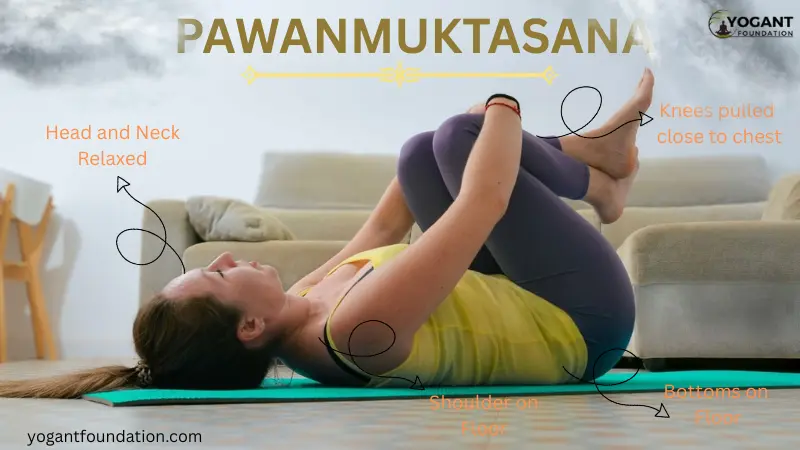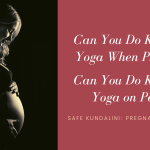pawanmuktasana
Have you ever experienced an uncomfortable pressure in your abdomen, feeling a panic that won’t move? Or maybe you’re looking for an easy but effective option to calm your mind and body after a long day of work? We’ve all been there! Modern lifestyles, fast-paced lives, and occasionally poor diet choices can leave us feeling inferior.
And what if we told you there is an ancient yogic solution to these common discomforts? A pose so simple and effective that it is often called a mini-detox for your entire body? Welcome to Pawanmuktasana, or wind-relieving pose.
At our school, we want to give you the tools you need to be able to help yourself. Today we will begin a journey exploring Pawanmuktasana, including not just how to do it, but also the amazing benefits, its many different names, and about how long you can comfortably stay in this liberating pose.
Let’s release some tension!
What are the common names of Pawanmuktasana?
The Essence of Release:
Let’s begin by looking at the name itself. Pawanmuktasana means two Sanskrit words: “pawan,” meaning wind or air, and “mukta,” meaning release or freedom. So literally, it is the posture that helps you release wind!
With this direct benefit, it is no wonder the most popular English interpretations are
- Wind-Relieving Pose: The most common and accurate translation.
- Gas Release Pose: Often used casually to refer to its direct effect.
- Knees-to-Chest Pose: More of a descriptive name, but it’s the way many beginners learn it first and describes the physical action appropriately.
The names may seem a little functional, but they capture the true goal of this pose—a feeling of lightness and relief from any internal bust.
How to Do Pawanmuktasana
Anatomy of Release:
The beauty of Pawanmuktasana is its accessibility. You don’t have to be an experienced yogi to enjoy its benefits. Here is a simple, step-by-step guide to help you safely enjoy learning how to do pawanmuktasana:
Preparation:
Lie down flat, on your back, on your yoga mat in a comfortable, quiet space. Allow your body to settle to the mat. Begin to take some deep breaths as you allow your awareness to come back inwards.
One-Legged Variation (guaranteed to please beginners or anyone sensitive in their lower back):
- Inhale: Gently bend your right knee and draw it to your chest.
- Exhale: Interlock your fingers over your right shin below your knee, or if you are more comfortable, behind your thigh.
- Gently Compress: As you exhale, lightly press your thigh towards your abdomen. You don’t want to force, but rather create a gentle, steady compression. Your left leg should be active and extended, or you can bend your left knee and have your foot flat on the ground if you feel your lower back is too sensitive.
- Relax: Keep your shoulder and neck relaxed and lightly press your lower back into the mat. Don’t strain your neck trying to lift your head too hard!
- Release: With your next inhale, gently let go and extend your legs back down.
- Repeat: Take a moment to notice and feel the difference in your two sides, and repeat with the left leg.
Both Legs Exercise (for a deeper abdominal massage):
- Inhale: Supportively bend both knees into your chest.
- Exhale: Link your fingers over both shins.
- Gently Press: As you exhale from here, gently press your thighs towards your abdomen (keeping in mind that it is gentle compression we are focusing on here).
- Optional Head Lift: If your neck is relaxed and strong, when you exhale, you can also gently lift your head towards your knees, which will deepen the abdominal compression (but equally important is that your neck must be relaxed; if you feel yourself straining or overworking, then just keep your head on the mat).
- Lower Back: Again, let your lower back be as connected to the mat as possible.
- Release: With your next inhale, gently let go and extend your legs down.
Common Mistakes to Avoid:
- Neck Straining: Can happen easily. It is important to remember the intended benefits are for the abdomen, not for the neck.
- Lower Back Raising: Be mindful of keeping your lower back slowly pressing into the mat to protect your spine.
- Holding Breath: Be sure to link breath with slow, deep breathing.
- Knees Forcing: Listen to your body! Gentle compression is much better than painful compression.
Pawanmuktasana Benefits
The Ripple Effect
Aside from helping with gas (and it does very well!), Pawanmuktasana benefits ripple through your entire system, impacting digestive, musculoskeletal, and even mental well-being.
- Digestive Benefits: Here is where Pawanmuktasana shines! The gentle compression of your thighs against your abdomen is akin to a massage of internal organs that boosts your digestive system. The compression encourages the release of trapped gas, reduces bloating, and even promotes regular bowel movements. An internal ‘cleanse’ and renewal!
- Lower Back Benefits: If you sit, you’ll notice how Pawanmuktasana softly expands the lower back and relieves spinal pain. It decompresses the spine, offering much-needed relief from tight or stiff lower back discomfort.
- Mainly Stretching: Although it may seem strange, holding the pose gently engages your abdominal muscles; over time, this can work toward assisting mild core strengthening for you.
- Soothing the Mind: The release of tension in the abdomen is often accompanied by a release in the mind. Pawanmuktasana involves simply connecting with your breath and the sensations in your body to help you kick in your parasympathetic nervous system—your “rest and digest” mode. This can help relieve stress and anxiety and improve sleep.
- Better Blood Flow: The compression and release action helps improve the blood flow to the organs in your abdomen so that they are nourished with new blood that brings the essentials we need to function and discharges waste.
How Long to Hold Pawanmuktasana
The Art of Stillness:
In terms of how long to hold Pawanmuktasana, always listen to your body, not your watch. Your breath is your best indicator.
- For Beginners: Hold each side (or two-leg variation) for 5-7 intentional, deep breaths. This gives your body a chance to settle into the pose and for effects to begin to show without any sense of rushing.
- As you progress: As you develop comfort in the posture, you can begin to gradually increase your holding time to 7-10 breaths, and even up to a minute or more, as long as it feels comfortable and productive.
- Repetitions: You can also look to do 2-3 repetitions on each side (if you are doing single leg), or you can also do 2-3 rounds of the double-leg variation.
Always remember, you are looking to find a sense of release and ease, not push through discomfort. If you are experiencing any sharp pain, please ease out of the pose gently.
Beyond the Mat: Integrating Pawanmuktasana into Your Life
Pawanmuktasana is more than just a stretch; it is an everyday well-being tool! When you consider it, try to use it.
- Before Getting Out of Bed: A great way to begin your digestion and slowly wake up your body.
- Before Bed: A nice way to wind down and let go of the tension you developed during the day before sleep.
- After a Long Day: If you have been sitting for the past 3-4 hours (or more!), it is a quick and easy stretch to relieve any lower back stiffness.
A Note of Caution: If you are pregnant (especially in later term), have had abdominal surgery recently, have a hernia, or have a serious back condition, please consult with your doctor or a qualified yoga instructor before doing Pawanmuktasana. Again, always adapt the pose based on how your body is feeling on that day.
Your Journey to Greater Ease
Pawanmuktasana exemplifies the idea that even the most common of things can have the most significant results. If you practice this soft yet powerful posture for only a few minutes each day, you will experience more digestive peace, gradually release tension in your lower back, and create a calmer, more balanced mindset.
Are you ready to feel the transformational nature of yoga yourself? Check out our website to see what Foundational Yoga Classes we have to offer you, where you will give a certain depth to your practice and play with poses including Pawanmuktasana under qualified guidance and support. Come join our community and experience true health and wellness!
What are your favorite ways to decompress? Let us know by leaving a comment below!


